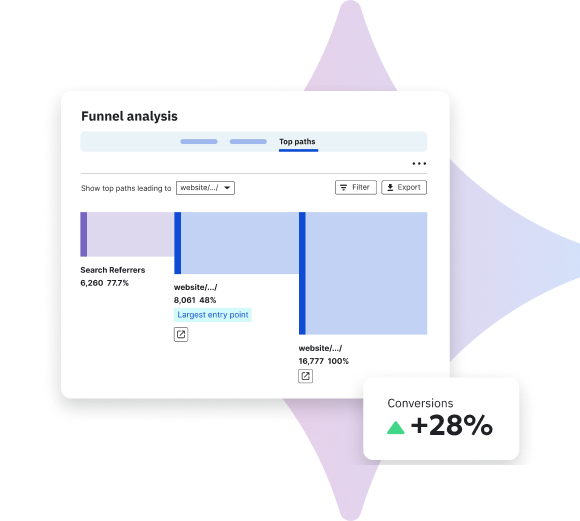While most marketers today are trying their best to use data and make more informed decisions, many find it tough to find actionable next steps from the raw metrics. According to IBM, 25 quintillion bytes of data are created every single day – that’s a number with 18 zeros! Staying on top of this massive volume of data can be overwhelming, even for those with a solid strategy and traditional data tools.
Much of this struggle can be attributed to two key issues:
- It’s tough to set up true goals and actions that properly represent how your site is being measured by the business
- Many reporting methods lack a way to draw actionable conclusions and use them to drive change
According to Gartner, poor data quality costs organizations an average of $15 million per year. If you don’t have accurate or revenue-based data to feed this understanding, it’s difficult to drive change relative to true ROI.
With automated reporting and the right goal tracking in place to do the heavy lifting, you can free up your team's time to find what’s impacting your goals (and give you the data you need to get those goals back on track). Once you have automated processes in place to capture this data and proper platforming to help drive change, it becomes easy to roll out incremental revenue for your organization.
I’ve broken down how you can break down your data challenges into more manageable steps, supported by the right tools. Let’s dive in.
Step 1: Plan and define
To effectively improve data quality, you need to first understand where your organizational gaps exist. Proper and accurate event tracking is key to defining and understanding digital success today, but this can be time consuming.
Organizations must ensure their event-based data is error-free and accurate. You need to recognize if this is a gap in your organization and seek help if you need it, to make sure you have the right foundations for reporting success. Third-party tools and services can do this for you today: let them take care of the heavy lifting so you can have the confidence you need in your data as you move into analysis processes.
Step 2: Set up and build
Once you’re sure about the quality of your data, the next step is to set up a system that brings it to you with minimal fuss. Using the techniques we mentioned above in the planning section, you can refine your process to automatically receive that data with as little effort as possible and on an ongoing basis.
But it’s not just about collecting data: it’s about understanding it.
Define how you’ll categorize different user actions that align with your goals. Get specific with how you track user paths through UTMs and parameters – it’ll give you a clearer picture than just looking at general traffic. The more granular you can get with user acquisition segmentation, the more accurate your behavior analysis processes can be.
Without this, you are just stuck with macro segments (like organic or paid traffic as a whole), instead of specific campaign data, that do not tell the whole story on what drove your user to your site, and by extension, whether they converted or not.
Keep it structured but straightforward, and you’ll have a data-driven approach that really drives results.
Step 3: Disseminate
When you establish a process for your content marketing team to get this information easily, you’re removing any room for error and giving them the data they need to drive action. The key is to try to be proactive with goal reporting to various departments, and to send out reporting before you hit your goal targets to give plenty of time for remediation.
There are two things here to focus on: automation and accuracy.
By automation, I mean you need to create a process that doesn’t take up your time. When content marketing teams set up systems that automatically keep tabs on important stats as time goes on, it makes reporting much easier. This not only speeds up how quickly reports get done, but also frees up people to concentrate on making better strategies and top-notch content. Finding the right mix between making things automatic and staying flexible is crucial. While setting up these automatic processes, it's important for teams to keep them adaptable so they can handle any new stats or report changes without needing a ton of extra time or effort.
When it comes to accuracy, setting and explaining tangible goals accurately sounds like a no-brainer but in practice, it’s easier said than done. For content marketing teams, it means laying out clear and specific objectives to ensure that the final reports truly reflect all the wins and contributions made by the team. Crafting these goals takes careful thought because they need to:
- match up with the bigger business goals
- be something you can measure
- be realistic while showing real impact
When goals are accurate, everyone on the team and the stakeholders get on the same page. Clear and specific goals don't just make reporting more precise; they also show exactly how valuable the content marketing work is. It's important to keep checking and tweaking these goals regularly. This way, they stay relevant and spot-on even if things change in the market or business priorities shift.
Step 4: Action data
Thanks to the work you’ve just completed, you should now have more time to reallocate towards analyzing user behavior relative to your goals and campaigns.
Apply segments related to poor performing campaigns, or negative-impacting user sources to funnels, to find friction points for those users. Where do they drop off in the funnel? Where do we lose them relative to the conversion?
Something I recommend to customers are behavior maps, which includes heat maps. Not every tool can do this, but being able to segment your heat maps is so valuable to understanding how users engage with your content. Aim a behavior map at the page with the segment discussed in the previous paragraph to understand why. How did they behave on that page? What did they search for on that page, click on, or scroll to? Is there information missing that they are looking for to encourage that next step along the conversion pathway? Determine this by analyzing that segment’s behavior to drive data-driven change to that page, pathway, or even campaign copy to better encourage conversions in the future.
If you are still not predicted to hit your goals, rinse and repeat the above stages to see what else can be remediated based on data.
In summary
When you put the right processes in place, your organization can stop spending time and energy on gathering information and can instead focus on enacting the change they need. With automated tools looking at the right places, you can build a foundation to drive incremental growth and find actionable next steps from your business’s data.
Want to learn more about Siteimprove can help? Our advanced reporting tools help our users find actionable insights from the data and stay aligned with their overall goals.

Ready to make the most out of your Web Analytics?
Siteimprove Analytics is an all-in-one Web Analytics solution
Schedule a demo
Matthew Bebenek
Matthew is Global Head of Presales, Solutions and Value Engineering at Siteimprove. He’s dedicated to helping organizations big and small obtain actionable organic and paid search analytics to avoid analysis paralysis when it comes to driving brand awareness and traffic, typically brought on by overwhelming amounts of data.
